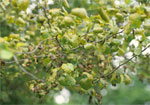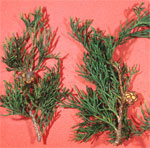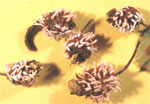Download Cedar-Apple Rust factsheet (PDF) (PLPA-104)
The symptoms of cedar-apple rust is commonly seen on apples, crabapples, and red cedars.
CAUSAL AGENT and DISEASE CYCLE
Cedar-apple rust is caused by a fungal pathogen, Gymnosporangium juniperi-virginianae. This fungus must spend a phase of its life cycle on both the red cedar and apple (or crabapple
tree). Gymnosporangium form galls on the cedar. Typically these galls grow on the cedar for 2 years. In the spring, matured galls will produce bright orange soft tendrils, known as telial horns or spore horns. Spores formed on the cedar are transmitted to the apple tree via air currents. After disease occurs on the apple tree for a period of time, small whitish paper-like tubular projections can appear on the underside of leaves or on the fruit. These structures are called aecia and will produce spores that will infect the red cedar and form new galls. These spores will not reinfect apples.
SYMPTOMS
Telial horns typically forms during the rainy spring season. Young apple leaves (4 -8 day old) are most susceptible to infection. A film of water on the apple host is required for infection to occur. One to two weeks after infection, yellow spots will appear on the tops of the leaves. These spots can increase in size up to ¼ inch and will have a rusty appearance. Aecia, the paper-like tubular structures, will appear on the underside of leaves or on fruits approximately one to two months after the first yellow spots wereobserved. Spores from the aecia are release in the late summer and may infect young twigs of the cedar tree. Small galls may be apparent in the following spring.
MANAGEMENT
- Grow resistant varieties of apples or crabapples. Apple varieties that reportedly have good resistance include Red Delicious, Molly Delicious, Empire. Additional information on varieties can be obtained at http://aggiehorticulture.tamu.edu/extension/fruit.html .
- Remove and destroy galls from the cedar tree before the telial horns are formed to reduce spores in the spring.
- Remove and destroy apples, crabapple, cedars or junipers that are growing wild nearby.
- Fungicides may be used in a consistent spray schedule to manage this disease on apples. Myclobutanil (Immunox) and Bordeaux mixture are a few of the fungicides are available to the homeowners for use. Homeowner should read and understand the fungicide label. Additional help with fungicides and how to use them can be obtained from your local County Extension agent.
Prepared by Dr. Kevin Ong
Assistant Professor and Extension Urban Plant Pathologist
Texas AgriLife Extension Service; The Texas A&M University System
April 1, 2005 (rev. 032508)
The information given herein is for educational purposes only. References to commercial products or trade names are made with the understanding that no discrimination is intended and no endorsement by Texas AgriLife Extension Service personnel is implied.
Educational programs of the Texas AgriLife Extension Service are open to all people without regard to race, color, sex, disability, religion, age, or national origin.
The Texas A&M University System, U.S. Department of Agriculture, and the County Commissioners Courts of Texas Cooperating


